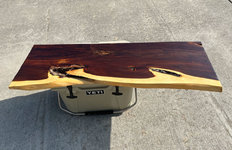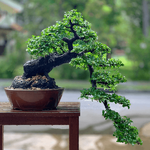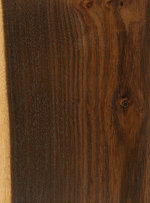Proud father of a blooming Texas ebony!
- Thread starter Bonsai Nut
- Start date
atlarsenal
Omono
Congratulations on your new bundle of joy! 
No it's not, that's great! I've only had a BRT bloom once and I was so excited. Congrats! (I know yours is a different tree but somewhat similar)It's a small thing..
19Mateo83
Masterpiece
It’s so pretty! 
Firstflush
Chumono
Kind of reminds me of a myrtus communis flower.
Bonsai Nut
Nuttier than your average Nut
rockm
Spuds Moyogi
Finding one big enough to get lumber from is not really easy. It's mostly a desert shrub.Yes. It is not a true ebony (Diospyrus sp.) but the wood is still very beautiful! It is very hard and dense, and almost sinks in water.
View attachment 454955
Texas Ebony - TX - American Forests
American Forests Champion Tree – Status: Champion Scientific Name: Ebenopsis ebano Genus: Ebenopsis Points: 255 State: TX
 www.americanforests.org
www.americanforests.org
penumbra
Imperial Masterpiece
Maybe for dollhouse furniture.Finding one big enough to get lumber from is not really easy. It's mostly a desert shrub.
Texas Ebony - TX - American Forests
American Forests Champion Tree – Status: Champion Scientific Name: Ebenopsis ebano Genus: Ebenopsis Points: 255 State: TXwww.americanforests.org
Maiden69
Masterpiece
Definitely, they look like a slightly oversize crepe myrtle.Finding one big enough to get lumber from is not really easy. It's mostly a desert shrub.
Texas Ebony - TX - American Forests
American Forests Champion Tree – Status: Champion Scientific Name: Ebenopsis ebano Genus: Ebenopsis Points: 255 State: TXwww.americanforests.org
Bonsai Nut
Nuttier than your average Nut
Finding one big enough to get lumber from is not really easy. It's mostly a desert shrub.
Texas Ebony - TX - American Forests
American Forests Champion Tree – Status: Champion Scientific Name: Ebenopsis ebano Genus: Ebenopsis Points: 255 State: TXwww.americanforests.org
For sure - same as true ebony. There is a reason why ebony is used for piano keys, pen blanks, knife handles... and not much else.
That said, though it is not commercially available, large Texas ebony slabs do exist. This one is selling on Etsy for $150. I remember researching the tree (and wood) when I first picked it up. Believe it or not, Texas ebony is actually a legume, and they produce bean pods

Last edited:
rockm
Spuds Moyogi
Another familiar Texas tree, the mesquite, is also a legume. You can also eat the beans in the seed pods and the pods as well...For sure - same as true ebony. There is a reason why ebony is used for piano keys, pen blanks, knife handles... and not much else.
That said, though it is not commercially available, large Texas ebony slabs do exist. This one is selling on Etsy for $150. I remember researching the tree (and wood) when I first picked it up. Believe it or not, Texas ebony is actually a legume, and they produce bean podsYou can eat the beans... if you can open the pod(!) It took me two vice grips and saw to open one that had been given to me as a gift... though I had no trouble getting the beans to sprout.
View attachment 454958
Maiden69
Masterpiece
I used plenty of ebony for guitar building. There used to be a lot of pieces like that and way bigger on the market pre-2020... now there is not that much out there. Like you said, mostly for small instruments and small woodworking and accents.For sure - same as true ebony. There is a reason why ebony is used for piano keys, pen blanks, knife handles... and not much else.
That said, though it is not commercially available, large Texas ebony slabs do exist. This one is selling on Etsy for $150. I remember researching the tree (and wood) when I first picked it up. Believe it or not, Texas ebony is actually a legume, and they produce bean podsYou can eat the beans... if you can open the pod(!) It took me two vice grips and saw to open one that had been given to me as a gift... though I had no trouble getting the beans to sprout.
View attachment 454958
This website used to have an immense variety of ebony, including big slabs... but all I found today was small boards, and very few with the live edge attached. There is a mill close to me that used to have some Texas ebony, I just looked at their website and all I see is pecan, mesquite, live oak and black walnut.
Gilmer Wood Company
 www.gilmerwood.com
www.gilmerwood.com
Gilmer Wood Company
 www.gilmerwood.com
www.gilmerwood.com
Bonsai Nut
Nuttier than your average Nut
I used to go here:
 inet.austinhardwoodsonline.com
inet.austinhardwoodsonline.com
Note that they list Gaboon Ebony and Santos Rosewood... but no Texas Ebony.
Exotic Lumber
One of Southern California largest selections including: Bastongne Walnut Figured Bubinga Goncalo Alves Ebony Gaboon Jatoba Koa Lacewood Mappa Burl Mesquite Monkey Pod Padauk Pau Ferro Peruvian Walnut Purple HeartRed Zebrawood ( Ebiara)Santos Rosewood Shedua Thuya Burl Wenge Quarter Sawn...
Note that they list Gaboon Ebony and Santos Rosewood... but no Texas Ebony.
Leo in N E Illinois
The Professor
- Messages
- 11,465
- Reaction score
- 23,766
- USDA Zone
- 5b
I once had a long conversation with a PhD botanist, Leonid Averynov, who was working for the government of Viet Nam, mapping biodiversity hot spots to help them site their future national parks. We talked about the fact that old growth forests, tropical forest and exotic hardwoods ARE NOT RENEWABLE resources. For example Diospyros, ebony species he was studying in Viet Nam, it is not the Sri Lanka ebony of the piano keys, but it is a very desirable hardwood. It takes 50 years for the first 1/4 inch of the valuable heartwood. A tree with 4 inches diameter of heartwood is in the 400 year old range. Many of the trees cut in old growth Vietnamese forest were over 500 years old. When it takes half a millennium to regenerate "old growth", the resource can not be viewed as a renewable resource. Its a sad thing, but these forests, once cut, can never be "replaced". Diospyros, the ebony family, Dalbergia, the rosewood family, and other rare hardwoods are globally in serious trouble because they are not renewable resources.
The conversation happened because I volunteered to be Leonid's chauffeur for the weekend. Leonid's hobby is raising orchids, and observing orchids while he is professionally assessing forests for Viet Nam and other countries. He had just published a book on the orchids of Viet Nam. I picked him up from the Chicago ORD airport and drove him to the conference in Milwaukee, where he was featured speaker and was selling his book. The 2 hour drive allowed a long conversation about forests, trees, orchids, vodka, and all manner of things.
By the way, Indian Rosewood, Dalbergia sissoo is probably the fastest growing of all the Dalbergia, and even here it takes 50 years to get just a fletch of "rosewood" heartwood. It is a pretty Fabaceae tree, so a distant cousin of Texas Ebony to bring it around to the current topic, but its flowers are more pea like rather than pompom like as in Texas Ebony. But it has compound leaves less than 6 inches long. It could be used as bonsai.
The conversation happened because I volunteered to be Leonid's chauffeur for the weekend. Leonid's hobby is raising orchids, and observing orchids while he is professionally assessing forests for Viet Nam and other countries. He had just published a book on the orchids of Viet Nam. I picked him up from the Chicago ORD airport and drove him to the conference in Milwaukee, where he was featured speaker and was selling his book. The 2 hour drive allowed a long conversation about forests, trees, orchids, vodka, and all manner of things.
By the way, Indian Rosewood, Dalbergia sissoo is probably the fastest growing of all the Dalbergia, and even here it takes 50 years to get just a fletch of "rosewood" heartwood. It is a pretty Fabaceae tree, so a distant cousin of Texas Ebony to bring it around to the current topic, but its flowers are more pea like rather than pompom like as in Texas Ebony. But it has compound leaves less than 6 inches long. It could be used as bonsai.
Leo in N E Illinois
The Professor
- Messages
- 11,465
- Reaction score
- 23,766
- USDA Zone
- 5b
How weird you mentioned this I was just looking for ebony and rosewood seeds b/c of bnut's post. I came across Dalbergia Latifolia, it says they call it Jacaranda in some places.
Glad to help. Common names, are frequently misleading. Most of the time Jacaranda will get you a Brazilian tree naturalized as an ornamental into southeastern USA. Use the botanical names, Dalbergia will get you exactly that, Dalbergia. Rosewood by any other name.
Little known fact, the North American Persimmon, Diospyros virginiana, is related to the true ebony trees. If you can find a Diospyros virginiana more than 100 years old, it will have an inch or two diameter of true black ebony heartwood, just like tropical ebony. The difficulty is, 150 year old and older Diospyros virginiana are very very rare.
Bonsai Nut
Nuttier than your average Nut
Get some true mahogany. Swietania mahogani is, believe it or not, a Florida native. It is a tree with compound leaves where the individual leaflets remind me a lot of ficus.How weird you mentioned this I was just looking for ebony and rosewood seeds b/c of bnut's post. I came across Dalbergia Latifolia, it says they call it Jacaranda in some places.
Dalbergia is the genus that includes quite a number of tropical hardwood species. Dalbergia latifolia is Indian Rosewood. I have never heard of it being called jacaranda - which is a completely different genus.
Jacaranda mimosifolia is the common jacaranda most often seen everywhere in SoCal and Florida. I, personally, would skip it. Ugly, leggy growth with long compound leaves. Last tree to bud out in the spring. First to drop leaves in the fall, with no fall color. For two weeks in the summer it bears the most beautiful blue flowers... but the rest of the year it looks like trash.
Personally, if I were looking for a tropical hardwood species to grow, it would be Gaboon ebony, Diospyros crassiflora (yes, it belongs to the same genus as princess persimmon, another of my favorites). Haven't found one yet, but they supposedly make good bonsai.

Crazy Diamond
Omono
Dalbergia nigra native to Brazil is commonly called Jacarandá da Bahia or Bahia rosewood, in the states the more common name is just Brazilian rosewood, the holy grail of tone woods for guitarsDalbergia is the genus that includes quite a number of tropical hardwood species. Dalbergia latifolia is Indian Rosewood. I have never heard of it being called jacaranda - which is a completely different genus.
Bonsai Nut
Nuttier than your average Nut
So what do they call a jacaranda tree that lives down by the bay?Dalbergia nigra native to Brazil is commonly called Jacarandá da Bahia or Bahia rosewood, in the states the more common name is just Brazilian rosewood, the holy grail of tone woods for guitars
Similar threads
- Replies
- 5
- Views
- 2K
- Replies
- 27
- Views
- 3K


